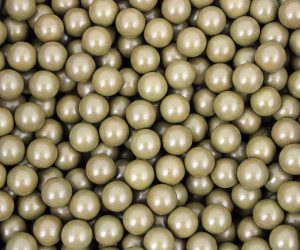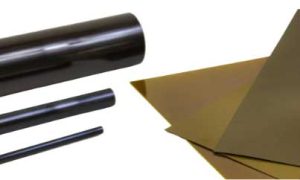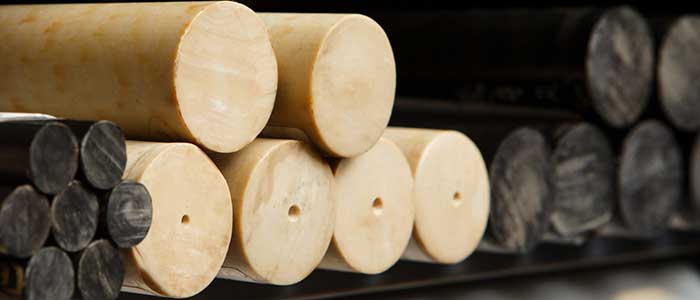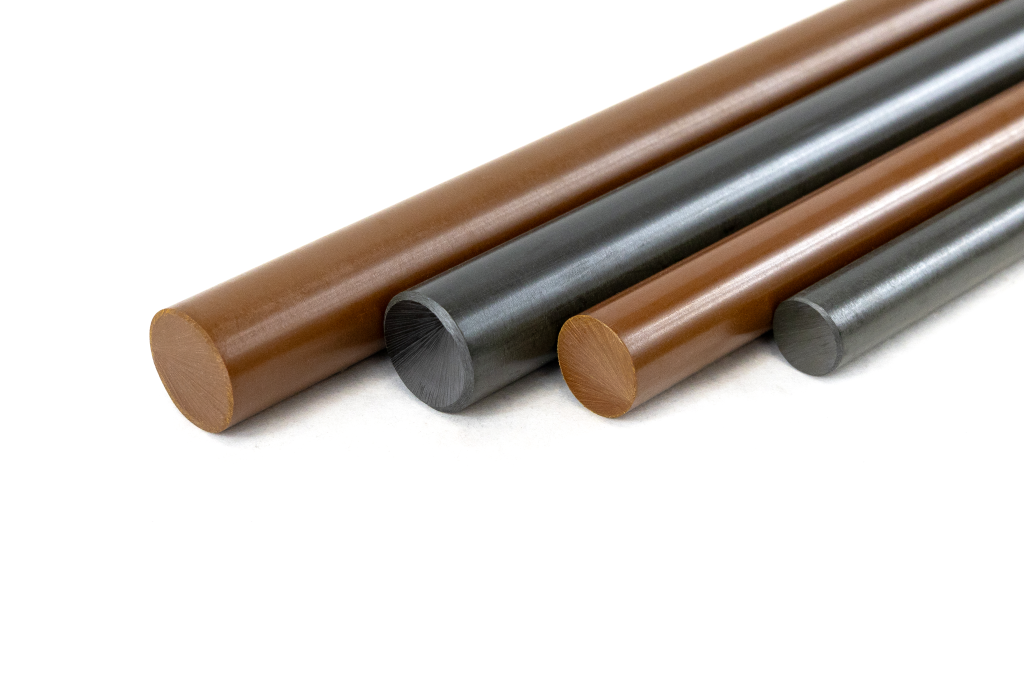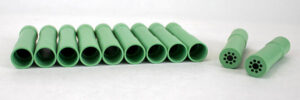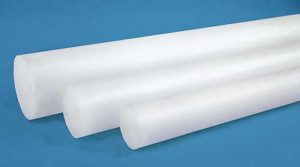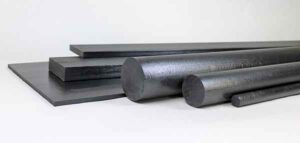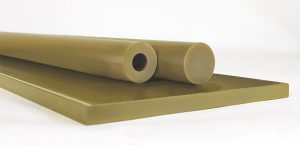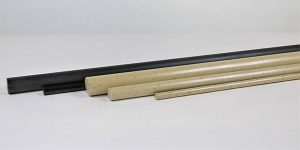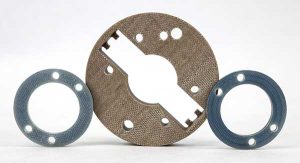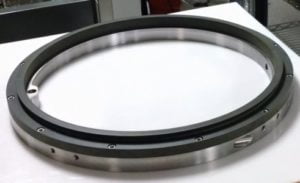Few materials can handle the high pressures, extreme temperatures, aggressive chemicals and rough handling that equipment in the oil and gas industry experiences. Drake Plastics’ specializes in ultra high-performance engineering plastics that are up to these challenges. All have a field-proven track record in reducing downtime, extending service life and improving reliability under the most demanding conditions in oil and gas operations.
Drake’s versatile materials portfolio includes a range of Victrex® and KetaSpire® PEEK, High Temperature PEEK XT, Victrex HT PEK, Torlon PAI, Ryton® R-4 PPS, Ultem™ PEI and AvaSpire® PAEK grades. We convert these exceptional materials into extruded machinable stock shapes, precision CNC-machined parts and injection molded shapes and components used in exploration, logging, drilling, workover and production equipment, and in pumps, valves and compressor components for mid-stream operations.
Each of these high-performance thermoplastics offers unique combinations of structural rigidity at high temperatures, impact strength at low temperature extremes, electrical and thermal insulative properties and resistance to frictional wear, corrosion and chemical attack. The diverse property combinations available within this materials portfolio provide engineers with solid options for dependable performance tuned to each application’s operating environment.
As melt-processable thermoplastics, Drake’s high-performance materials can be injection-molded and extruded into machinable stock shapes. This production versatility affords virtually unlimited injection-molded and CNC-machined part configurations for oil and gas applications.
Oil and Gas Applications in Drake’s High-Performance Materials
In over two decades of working with engineers on designing and producing components for exploration, logging, drilling, workover, production and distribution equipment, Drake’s application development team has compiled an impressive list of successes like these:
- Artificial lift ESP connectors and Insulators made from PEEK, Glass Reinforced PEEK, High Temperature PEEK XT and Victrex HT PEK provide the high voltage electrical insulation required in the demanding environments where electric submersible pumps must operate. Drake offers porosity-free connectors with over-molded or pressed-in beryllium copper pins and inserts.
- Frac Balls: Torlon PAI sets the high bar on performance among material options in Drake’s frac and activation balls. They offer impressive creep resistance, compressive strength and toughness compared to other thermoplastic materials.
- Extreme Duty Frac Balls: For ultimate strength and reliability, Drake offers Cannonball® composite Frac Balls. They are machined from an ultra-high strength composite that withstands pressures up to 10 KSI on seat interferences as low as 2%, allowing 60 zone systems. Cannonball frac balls are machined to precise tolerances of +/- 0.0015” (0.038mm) consistently, ball-to-ball and lot-to-lot.
- Specific Duty Frac and Activation Balls: Drake also offers other high-performance thermoplastics such as KetaSpire and Victrex PEEK, Ultem PEI or dissolvable PGA as machined balls to meet specific downhole operating conditions and requirements.
- Seals and back-up rings machined from 30% glass and carbon fiber-reinforced PEEK have the strength needed to prevent elastomers from extruding under pressure.
- Logging tool insulators and chassis made from glass fiber-reinforced KetaSpire KT820 GF30 PEEK provide the strength, dimensional stability, and temperature, electrical and chemical resistance needed in modern logging tools.
- Connector bodies rely on PEEK, Victrex HT PEK and High-Temperature PEEK to isolate conductive pins in and perform reliably in electrical applications including those in sub-sea equipment.
- Custom sucker rod guides and blazers made by Drake address specific field or well problems of chemical attack, short life or casing wear. The material is selected based on the specific needs of the well or field. Contact Drake for more information.
- HTHP cement flappers made from 30% glass-reinforced Torlon 5030 PAI have the strength of aluminum but are easily drillable.
- Poppets and lift buttons for reciprocating compressor applications gain high strength and wear resistance from carbon reinforced PEEK.
- Lantern rings and downhole insulators made from 40% glass-reinforced Ryton R-4 have the chemical and temperature resistance and strength needed for long-term performance.
- Activation seats: Torlon 4203 Ball seats allow devices such as wellbore enlargement tools to be deployed, activated and retracted on a single ball seat. The seat yields sufficiently to allow a ball to activate the tool before passing through the seat without cracking or permanently deforming the seat, making it ready for subsequent stimulations at very similar pressures to prior activations.
PEEK: Solid Physical Properties, Exceptional Chemical and Hydrolysis Resistance
Drake’s versatile high-performance polymers provide different combinations of properties that mesh effectively with the end-use conditions and performance requirements of a variety of oil and gas industry equipment applications.
While Torlon PAI offers uniquely superior strength retention at high temperatures compared to all other melt-processable thermoplastics, PEEK stands out with a solid balance of overall physical properties and chemical and hydrolysis resistance beyond the capabilities of most polymers. Several PEEK formulations with different property profiles have been developed by Victrex plc under the Victrex® PEEK brand and by Solvay under the KetaSpire® PEEK tradename. Unfilled, high strength and wear-resistant grades are available from Drake in the widest selection of Mil-P compliant extruded stock shapes available (up to 10” rod currently) as well as injection molded and precision-machined parts.
Typical PEEK applications in oil and gas equipment are similar to those of Torlon PAI and include seals, valve seats, chassis for electrical apparatus in logging operations. Among the variety of PEEK grades are formulations with enhanced strength and bearing and wear properties coupled with the high-performance thermoplastic’s inherent resistance to chemicals and hydrolysis. The growing list of applications in severe operating environments confirms the reliability and recognition PEEK in all its versatile forms has earned in the oil and gas industry.
PEEK Compliance: NORSOK M-710 and ISO 23936
NORSOK M-710 AND ISO 23936 standards have been developed for the global oil and gas industry to ensure that the non-metallic materials used as rigid back-up rings for elastomeric seals can maintain their physical properties and sealing function reliably throughout the intended lifetimes of these critical components.
Solvay and Victrex PLC supply the PEEK resins used in Drake PEEK stock shapes from which seal back-up rings are machined. Victrex® PEEK grades including PEEK 450G, and Solvay’s KetaSpire® PEEK formulations including KetaSpire KT-820 NT and 30% carbon fiber-reinforced KetaSpire KT-820 CF30 are NORSOK M-710 and ISO 23936 qualified for downhole use in sour gas and steam service.
Strength retention to 300°F (150°C)
With a glass-transition temperature (Tg) of approximately 302°F (150°C), PEEK’s strength retention at thermal extremes satisfies performance requirements for many downhole equipment applications. In addition, its melting temperature of 644°F (340°C) indicates PEEK can perform above its Tg depending on application variables such as the degree of physical load.
Glass and carbon fiber-reinforced PEEK grades add greater structural strength to the ultra high-performance thermoplastic’s assets for oil and gas equipment components. Drake offers stock shapes and precision-machined and injection molded parts in several of these higher strength options. They include Victrex 450 CA30 and Solvay’s KetaSpire KT 820 CF30 with 30 % carbon-fiber, and KetaSpire KT 820 GF30 with 30% glass fiber content.
Chemical and hydrolysis resistance for long term dependability
Superior resistance to degradation from the aggressive chemicals ranks high on the list of PEEK benefits for components associated with logging, drilling, production and transfer equipment.
PEEK also excels on resistance to long term exposure to wet environments including hot water and steam, a key consideration for many oil and gas applications.
In off-shore drilling applications, constant exposure to salt water adds a detrimental factor to an already corrosive drilling environment. Logging and drilling equipment may also extend for great distances and under water, making repairs and replacements a major problem. PEEK’s resistance to hydrolysis and chemical attack made it a strong material of choice for highly reliable components for equipment used in this difficult environment.
Exceptional wear resistance in dynamic load-bearing and frictional applications
As a semi-crystalline polymer, PEEK inherently resists abrasive wear. This has led to numerous specifications for the ultra high-performance polymer in bearings, bushing, thrust washers and sliding components.
Extending the performance of the standard grade, a PEEK formulation with PTFE, graphite and carbon fibers offers improved wear resistance for oil and gas equipment components that must withstand higher levels of friction and load. Designated Victrex 450 FC30 “10-10-10” PEEK, Drake produces stock shapes and precision-machined and injection-molded parts from this bearing and wear grade thermoplastic for applications that experience more severe dynamic loading.
High Temperature PEEK XT extends application range
A recent addition to Drake’s product portfolio, High Temperature PEEK XT adds improved thermal, mechanical and electrical properties to the inherent chemical and hydrolysis resistance of standard PEEK. This new resin development from Solvay extends PEEK’s range of applications into components with a more severe high temperature environment than standard grades can withstand.
Solvay offers a family of melt-processable unfilled and fiber-reinforced grades of its High Temperature PEEK under its KetaSpire® PEEK XT brand. It features a glass-transition temperature of 338° F (170° C), which is 36°F (20°C) higher than standard PEEK. The glass and carbon fiber-reinforced High Temperature PEEK grades add a higher level of structural strength that can benefit connectors and other oil and gas applications compared to the unreinforced High Temperature PEEK grade.
Drake offers injection-molded parts and can provide extruded rod, plate and precision-machined components made from unfilled KetaSpire® PEEK XT-920 NT, as well as the fiber-reinforced grades.
Torlon® PAI: Unparalleled Strength for Oil and Gas Equipment Components
Maximum strength at temperature extremes for structural integrity
At the 400°F (204°C) mark, Torlon® PAI maintains far higher strength than other melt-processable engineering thermoplastics exhibit at room temperature. In fact, this ultra high-performance polymer does not start softening until it reaches 530°F (276°C), which is its glass-transition temperature (Tg). Even after continuous high temperature exposure, it still retains the strength needed to serve many applications reliably.
Torlon PAI also has remarkable impact resistance at cryogenic temperatures, adding to its benefits for applications exposed to rigorous use in exploration, drilling, logging and workover operations.
Glass and carbon fiber-reinforced Torlon PAI formulations augment the inherent high strength of the unfilled PAI grade and are ideal for applications that see more severe physical loading. Well completion operations, for example, capitalize on 30% glass-reinforced Torlon 5030 PAI for rigid, rugged drillable cement flappers.
Drake also developed Torlon PAI Seamless Tube® in a wide array of OD/ID combinations. With no weld or knit lines, this unique seamless machinable shape has extremely high hoop strength under pressure on the inside or outside walls. The tube configuration also eliminates the time and cost of coring out rod to produce tubular and circular parts.
Corrosion resistance for valves, pumps and other downhole applications
Dimensional stability and insulative properties for electrical equipment components
Torlon PAI bearing and wear grades for long life in dynamic load applications
High strength Ryton® R-4 PPS (polyphenylene sulfide) with 40% glass fiber reinforcement fulfills numerous oil and gas equipment specifications for an extremely rigid thermoplastic that can maintain its structural strength at temperatures in excess of 400°F (204°C). The versatile material also has no known solvents below 392°F (200°C).
Ryton PPS’ inherent dielectric properties also rank among the best in the field of ultra high-performance polymers, a factor behind the selection of the material for connectors and insulators used in oil and gas logging and drilling equipment.
Drake’s Ryton R-4 PPS stock shapes and precision-machined and injection molded parts provide structurally strong and dimensionally stable downhole rod guides and centrifugal and lift pump components exposed to hot, aggressive chemicals. Its electrical and thermal insulative properties also make Ryton R-4 PPS a frequent choice for electrical connectors and insulators.
To support customer requests for this versatile material in machined parts, Drake’s R&D team developed the technology to extrude Ryton R-4 PPS with consistently high quality in a full range of rod and plate sizes. Resin certifications accompany each shipment of Drake’s Ryton R-4 PPS shapes and parts that now serve numerous production and prototype requirements.
PEK, PEKK and PEKEKK: High-Temperature Polyketone Options
Drake plastics also offers extruded stock shapes on a custom basis as well as injection molded parts made from high temperature-resistant polyetherketone polymers designated PEK, PEKK and PEKEKK. Each exhibits thermal properties comparable to High Temperature PEEK XT. However, the 2:1 ratio of ether (E) to ketone (K) in KetaSpire XT, a true PEEK polymer, affords it an advantage on chemical resistance.
A common application area for these higher temperature-resistant polymers is as insulators in downhole connectors such as those used with ESPs or electrical submersible pumps operating in high temperature and pressure downhole environments. Their strength and stiffness at higher temperatures prevents distortion from hydrostatic pressure in thin-walled bulkhead seal components.
Ultem PEI (polyetherimide) combines impressive electrical properties, strength and flexibility with resistance to acids and hydrocarbons and superior hydrolytic stability. Its thermal properties include a glass transition (Tg) temperature of 419°F / 215°C.
As an amorphous thermoplastic, it is specified for structural and electrical applications rather than bearing and wear components that are served by Drake’s line-up of crystalline and semicrystalline high-performance polymers.
In addition to offering rod and plate in various grades of Ultem PEI s on a custom basis, Drake Plastics extrudes Ultem 2300 Seamless Tube® from high strength 30% glass-reinforced PEI grade. Available from inventory in numerous OD/ID combinations, the unique seamless configuration delivers superior strength and stability in the hoop direction under high internal or external pressure.
Ultem 2300 PEI Seamless Tube® also eliminates excess machining time and material loss associated with coring out the center of rod for oil and gas industry equipment components such as insulators, bushings and thrust washers with a circular configuration.

